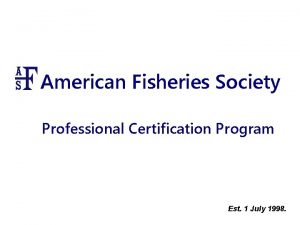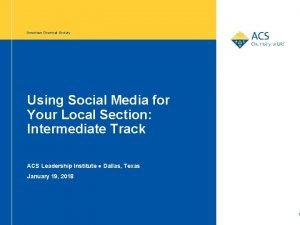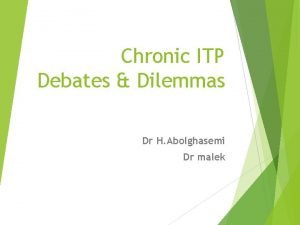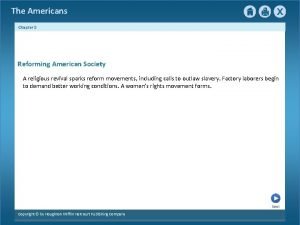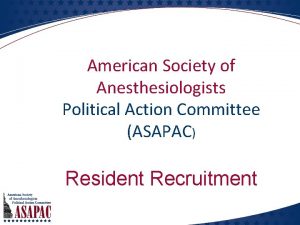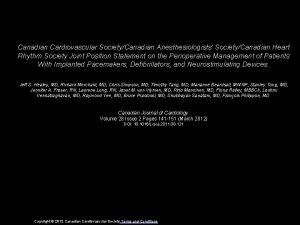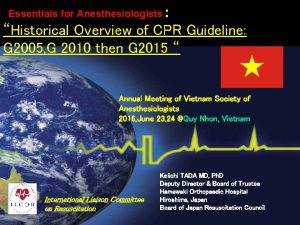Pacira v American Society of Anesthesiologists Summary of










- Slides: 10

Pacira v. American Society of Anesthesiologists: Summary of Report by Charles T. Mehlman, DO, MPH Concluding Conflict of Interest Reporting Standards Were Not Followed by ANESTHESIOLOGY 1

Charles T. Mehlman, DO, MPH Declarant • Board certified academic pediatric Orthopaedic Surgeon and Professor at the University of Cincinnati College of Medicine • Extensively published in the area of conflict of interest in medicine in national and international peer-reviewed journals, including the New England Journal of Medicine • Vast experience as a member of editorial review boards for multiple medical journals, including J Pediatr Orthop, J Orthop Trauma, J Child Orthop, The Spine Journal • Clinical researcher with over 130 peer-reviewed publications • Decade-long participant as a committee member or chairperson of the US News and World Report Pediatric Orthopaedic Work Group, which establishes the criteria used to rank children’s hospitals across the United States

The risks of bias in medical publications • Healthcare professionals frequently receive industry compensation for various work products – This remuneration—regardless of size—creates a risk that the outcomes of medical research and medical publications may be influenced by the payments • Journal editors also face the risk of being influenced in their editorial decisions, especially publication decisions, by compensation received from industry entities • Based on available literature, there does not appear to be any particular threshold regarding financial conflicts of interest 3

Acceptable measures to mitigate the risk of bias • It is imperative that publication authors accurately disclose industry relationships in their publications for purposes of transparency – Virtually all medical journals currently have some type of conflict-of-interest declaration policy for authors 1 – Many journals, including ANESTHESIOLOGY, utilize the ICMJE Uniform Requirements for Manuscripts Submitted to Biomedical Journals, emphasizing a commitment to author transparency to allow readers to make their own judgements • Publication editors should disclose those relationships and recuse themselves from publication decisions related to articles for which they have a conflict of interest – Multiple professional editors’ associations recommend that relevant conflicts of interest be disclosed and that editors recuse themselves if they have a potential conflict of interest with an article under consideration 2 ICMJE=International Committee of Medical Journal Editors 1. Okike K, Kocher MS, Wei EX, Mehlman CT, Bhandari M. Accuracy of Conflict-of-Interest Disclosures Reported by Physicians. N Engl J Med 2009; 361: 1466 -1474. 2. Hague W, Minhajuddin A, Gupta A, et al. Conflicts of interest of editors of medical journals. PLo. S One 2018; 13: e 0197141. 4

The ANESTHESIOLOGY journal website specifically states “Authors must disclose all commercial associations, including consultancies, equity interests, or patentlicensing arrangements. ” 5

ANESTHESIOLOGY failed to follow accepted conflict of interest disclosure protocols in two of the three EXPAREL-related publications ❶Narrative review article Ilfeld BM, Eisenach JC, Gabriel RA. Clinical effectiveness of liposomal bupivacaine administered by infiltration or peripheral nerve block to treat postoperative pain. Anesthesiology 2021; 134: 283 -344. • Narrative review articles are not recognized in commonly utilized hierarchies of evidence and their potential for bias is considered to be significant 1 -3 • This article “strikes a clear negative tone regarding the medication in question” • Two of the authors of the article (including the lead author) fail to disclose highly relevant conflicts of interest ❷Meta-analysis article Hussain N, Brull R, Sheehy B, Essandoh MK, Stahl DL, Weaver TE, Abdallah FW. Perineural liposomal bupivacaine is not superior to nonliposomal bupivacaine for peripheral nerve block analgesia. Anesthesiology 2021; 134: 147 -164. • This article takes a similarly adversarial position with respect to EXPAREL • Relevant financial relationships were withheld from readers of the article 1. Bhandari M, Guyatt GH, Montori V, et al. User’s guide to the orthopaedic literature: how to use a systematic literature review. J Bone Joint Surg-Am 2002; 84 -A: 1672 -1682. 2. Murad MH, Montori VM, Ioannidis JPA, et al. How to Read a Systematic Review and Meta-analysis and Apply the Results to Patient Care Users’ Guides to the Medical Literature. JAMA 2014; 312: 171 -179. 3. Murad MH, Asi N, Alsawas M, Alahdab F. New evidence pyramid. Evid Based Med 2016; 21: 125 -127. “A ‘narrative review’…offers ample opportunities for subjective assessment and opinion masquerading as fact…the risk of influence from subjective bias makes it particularly important to disclose any financial interests” – Charles T. Mehlman, DO, MPH 6

ANESTHESIOLOGY failed to follow accepted conflict of interest disclosure protocols in two of the three EXPAREL-related publications • Two of the authors of the narrative review fail to disclose highly relevant conflicts of interest – Dr Brian M Ilfeld (lead author) failed to disclose that UCSD—where he is a professor of anesthesiology—has received research support from Heron Therapeutics in 2020 and 2021, or that he received $14 million in Department of Defense funding for his research involving treatment modalities that compete with EXPAREL – Dr Rodney A Gabriel failed to report he received $2, 500 from Heron Therapeutics in October 2019 – Both authors failed to disclose additional funding received from Infu. Tronix, a pain pump that competes with EXPAREL • Ilfeld and Gabriel made this disclosure in other recent articles, but not in the Feb 2021 narrative review 1 -2 “It is…striking that a number of Brian M Ilfeld’s publications during the same timeframe do disclose his relationship with Heron Therapeutics. This raises a question of whether his omission of this relationship in the ANESTHESIOLOGY publication was truly inadvertent. These omissions…are all the more notable given the authors own admonition in criticizing purported bias within relevant articles included in their review, even overtly stating ‘… minimizing conflict of interest should be emphasized’” – Charles T. Mehlman, DO, MPH 1. Finneran JJ, Swisher MW, Gabriel RA, et al. Suture-method versus through-the-needle catheters for continuous popliteal-sciatic nerve blocks. Anesthesiology 2020; 132; : 854 -866. 2. Ilfeld BM, Khatibia B, Maheshwar K, et al. Ambulatory continuous peripheral nerve blocks to treat postamputation phantom limb pain: a multicenter, randomized, quadruple-masked, placebo-controlled clinical trial. Pain 2021; 162: 938 -955. 7

The Editor-In-Chief of ANESTHESIOLOGY shows himself to not be an unbiased referee and demonstrates many pro-opioid opinions • Dr Evan D Kharasch has an easily identifiable track record of comments, attitudes, and positions that are pro-opioid and effectively anti-EXPAREL – 2021 pro-opioid editorial: “Opioid-free anesthesia may be feasible. Nevertheless, it appears neither logical nor beneficial to patients. ” 1 – 2020 pro-opioid editorial: “Approaches to the management of perioperative pain should be less arbitrary and commercially influenced and more evidence-based than the practices that caused the opioid crisis in the first place. ” 2 – 2019 pro-opioid research: Kharasch and colleagues published favorable methadone-related research 3 – 2018 pro-opioid editorial: “For millennia, opioids have been a mainstay of pain treatment. ” 4 1. Kharasch ED, Clark JD. Opioid-free anesthesia: time to regain our balance. Anesthesiology 2021; 134: 509 -514. 2. Kharasch ED, Avram MJ, Clark JD. Rational perioperative opioid management in the era of the opioid crisis. Anesthesiology 2020; 132: 603 -605. 3. Komen H, Brunt LM, Deych E, Blood J, Kharasch ED. Intraoperative methadone in same-day ambulatory surgery: a randomized double-blinded dose-finding pilot study. Anesth Analg 2019; 128: 802 -810. 4. Rathmell JP, Kharasch ED. Frontiers in opioid pharmacology. Anesthesiology 2018; 128: 865 -866. 8

The Editor-In-Chief of ANESTHESIOLOGY failed to disclose millions of dollars in federal funding for opioid research • Dr Evan D Kharasch has received millions of dollars in federal funding to research opioids – – $566 K: Optimizing Out-Patient Anesthesia: Improving Analgesia and Reducing Opioid Misadventure $561 K: Methadone and HIV Drug Interactions $328 K: Addiction Therapy: Metabolism and Transport-Mediated Drug Interactions $109 K: Opioids in Cancer Pain and Drug Abuse – Optimizing Therapy • This is a clear conflict of interest that he should have disclosed, and he should have recused himself from publication decisions that implicate that conflict • Instead, his ANESTHESIOLOGY profile expressly declares that he has no conflict of interests “Not only are readers not able to weigh [Dr Evan D Kharasch’s] conflict of interest in their review of [the Feb 2021] ANESTHESIOLOGY articles, Dr Kharasch has affirmatively informed the readers that he has no such conflicts. ” – Charles T. Mehlman, DO, MPH 9

In summary “I have reviewed two publications in the February 2021 issue of ANESTHESIOLOGY related to [EXPAREL]. From my review it is clear that conflict of interest reporting standards were not followed with respect to the following articles: • Ilfeld BM, Eisenach JC, Gabriel RA. Clinical effectiveness of liposomal bupivacaine administered by infiltration or peripheral nerve block to treat postoperative pain. Anesthesiology 2021; 134: 283 -344. • Hussain N, Brull R, Sheehy B, Essandoh MK, Stahl DL, Weaver TE, Abdallah FW. Perineural liposomal bupivacaine is not superior to nonliposomal bupivacaine for peripheral nerve block analgesia. Anesthesiology 2021; 134: 147 -164. …These articles raise questions related to financial conflict of interest and appropriate disclosures, biased study design, and editorial influence over the overall message that was delivered regarding [EXPAREL]. ” – Charles T. Mehlman, DO, MPH 10
 Gertler econ
Gertler econ American society industrial security
American society industrial security Certified fisheries professional
Certified fisheries professional American chemical society
American chemical society American society of hematology
American society of hematology Clexane mechanism of action
Clexane mechanism of action Chapter 8 reforming american society
Chapter 8 reforming american society Weather studies introduction to atmospheric science
Weather studies introduction to atmospheric science American society of mechanical engineers
American society of mechanical engineers Chapter 6 american society in transition
Chapter 6 american society in transition American iris society awards
American iris society awards


